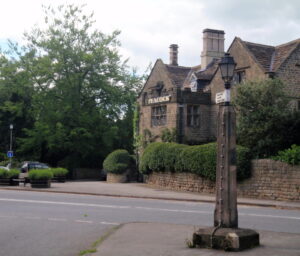ROWSLEY village
Rowsley is a small village located on the A6 north of Darley Dale on the road to Bakewell where the rivers Derwent and Wye merge. It is split into two parts – Great Rowsley, or Rowsley South, is on the west bank of the Derwent on the A6 Matlock to Bakewell road and Little Rowsley on the side road to Chatsworth. Great Rowsley is the oldest part but Little Rowsley had the largest population. Little Rowsley expanded and grew as a result of the railway arriving.
Both existed separately until they were amalgamated in a local government reshuffle of April 1987.
There was an Anglo-Saxon settlement here before the Norman Conquest, and `Rowesley‘ is mentioned in the Domesday Survey as an outlier of the Royal Manor of Bakewell, occupying the `tongue of fertile land between the Derwent and the Wye‘.
There are several interesting buildings in the ‘Great Rowsley’ part with the Derwent bridge being the oldest as it was originally a packhorse bridge that was eventually widened in 1925, as many were, to handle increased traffic flow and weight.
The Peacock Hotel with stables at the back built at the end of the seventeenth century stands out with most visitors – especially the carved peacock above the door.

Ivy House, standing directly opposite The Peacock was built a year earlier in 1651.
The Beeches and Holly House were built in 1710 as one dwelling and was thought to have been the Manor House home of Sir Francis Darwin until it was split at the end of the nineteenth century.
The village school was a gifted by the Duke of Rutland in 1840, as was the Church of St. Katherine of 1854-55 which stands on higher ground up Church Lane towards Haddon Woods.
The Peak Well or village fountain at Rowsley is located opposite the Peacock Hotel in Church Lane. It was carved towards the end of the nineteenth century by Trevis Bath who also carved the stone peacock above the front porch of the Peacock Hotel.
On the cross roads in front of the hotel there is an unusual lamp which was given by John Holmes a farmer and village blacksmith `in gratitude for 60 years at nearby Bridge House’.
Major changes took place in 1849 when the railway arrived at Rowsley.
Progression of the line from Buxton to Manchester was delayed for some time at Rowsley as both the Dukes of Devonshire and Rutland objected to it running through their estates. Eventually the Duke of Rutland agreed to the Midland Railway’s plans on condition that the track passed unseen behind Haddon Hall in a ‘cut and shut’ covered cutting. Sir Joseph Paxton had designed and built the Italianate station which can be seen in the shopping outlet but this was not needed for the new route.
The Midland Railway built a second station a quarter of a mile south at the end of the Wye Valley which was completed in 1863 along with a railway depot, sidings and the row of brick houses known as Midland Cottages to accommodate the railway workers.
The railway was axed by Beeching’s cuts and closed in the 1960’s along with the Rowsley Express Dairy site. Rowsley station became an engineering site and the old sidings became an industrial estate.
John Caudwell built what is now the only complete water-turbine powered flour mill in the country on the Wye in 1874 and Caudwell’s Mill still supplies a wide variety of flours and specialist foods.

